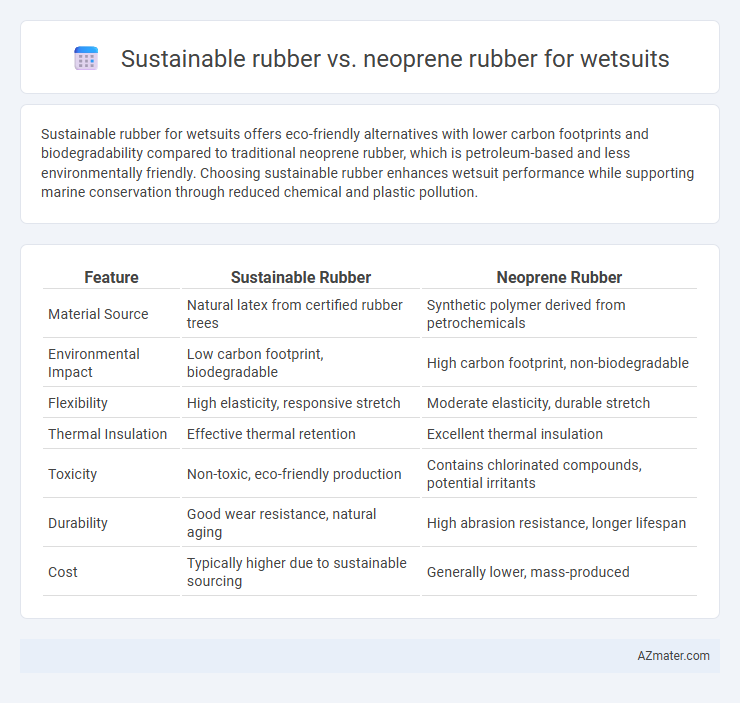Sustainable rubber for wetsuits offers eco-friendly alternatives with lower carbon footprints and biodegradability compared to traditional neoprene rubber, which is petroleum-based and less environmentally friendly. Choosing sustainable rubber enhances wetsuit performance while supporting marine conservation through reduced chemical and plastic pollution.
Table of Comparison
| Feature | Sustainable Rubber | Neoprene Rubber |
|---|---|---|
| Material Source | Natural latex from certified rubber trees | Synthetic polymer derived from petrochemicals |
| Environmental Impact | Low carbon footprint, biodegradable | High carbon footprint, non-biodegradable |
| Flexibility | High elasticity, responsive stretch | Moderate elasticity, durable stretch |
| Thermal Insulation | Effective thermal retention | Excellent thermal insulation |
| Toxicity | Non-toxic, eco-friendly production | Contains chlorinated compounds, potential irritants |
| Durability | Good wear resistance, natural aging | High abrasion resistance, longer lifespan |
| Cost | Typically higher due to sustainable sourcing | Generally lower, mass-produced |
Introduction to Wetsuit Materials
Sustainable rubber for wetsuits, often derived from natural latex or recycled sources, offers eco-friendly alternatives that reduce environmental impact while maintaining flexibility and durability. Neoprene rubber, a synthetic material widely used in traditional wetsuits, provides excellent insulation and chemical resistance but has a higher carbon footprint due to petroleum-based production. Choosing sustainable rubber materials supports marine conservation efforts and aligns with growing consumer demand for environmentally responsible wetsuit options.
What is Sustainable Rubber?
Sustainable rubber is derived from natural sources, harvested through eco-friendly processes that minimize environmental impact and support biodiversity. Unlike neoprene, which is a synthetic rubber produced from petroleum-based materials, sustainable rubber offers biodegradability and reduced carbon footprint in wetsuit manufacturing. The use of sustainable rubber in wetsuits promotes renewable resources and reduces reliance on fossil fuels, aligning with eco-conscious consumer demand.
Understanding Neoprene Rubber
Neoprene rubber, a synthetic polymer derived from chloroprene, is widely used in wetsuits due to its excellent thermal insulation, flexibility, and durability. Sustainable rubber alternatives, such as natural latex or bio-based neoprene, offer environmentally friendly options by reducing reliance on petroleum-based materials and decreasing carbon footprints. Understanding the chemical composition and physical properties of neoprene is essential for evaluating its environmental impact and potential for innovation in sustainable wetsuit production.
Environmental Impact: Sustainable Rubber vs Neoprene
Sustainable rubber, derived from natural and responsibly harvested latex, significantly reduces carbon footprint and minimizes toxic chemical usage compared to neoprene rubber, which relies on petroleum-based materials and energy-intensive manufacturing processes. Neoprene production involves chloroprene monomers, which can release harmful volatile organic compounds (VOCs) and contribute to environmental pollution and health risks. Choosing sustainable rubber for wetsuits supports biodiversity conservation and promotes biodegradability, reducing landfill waste and ocean pollution associated with traditional neoprene wetsuits.
Performance and Durability Comparison
Sustainable rubber wetsuits, often made from natural or plant-based materials, offer enhanced breathability and flexibility, improving overall comfort and mobility during water activities. Neoprene rubber provides superior thermal insulation and abrasion resistance, ensuring longer-lasting protection in harsh marine environments. While sustainable rubber excels in eco-friendliness and comfort, neoprene remains the preferred choice for durability and consistent performance in demanding wetsuit applications.
Comfort and Flexibility in the Water
Sustainable rubber, often derived from natural latex sources like guayule or Hevea brasiliensis, offers superior breathability and elasticity compared to traditional neoprene rubber used in wetsuits. This enhanced flexibility allows for greater freedom of movement and improved comfort during extended water activities, reducing fatigue and skin irritation. Neoprene, while durable and insulating, tends to be less pliable and heavier, potentially limiting range of motion and contributing to discomfort in prolonged use.
Health and Safety Considerations
Sustainable rubber, derived from natural latex sources, offers superior biodegradability and reduced chemical exposure compared to neoprene rubber, which contains chlorinated compounds and may release potentially harmful toxins during manufacturing and disposal. Natural rubber wetsuits minimize skin irritation and allergic reactions due to fewer synthetic additives, promoting enhanced wearer health and safety. Choosing sustainable rubber supports eco-friendly practices while reducing long-term environmental health risks associated with neoprene production and degradation.
Cost Analysis: Sustainable Rubber vs Neoprene
Sustainable rubber wetsuits generally have a higher upfront cost compared to traditional neoprene due to eco-friendly sourcing and processing methods. Neoprene remains more cost-effective for mass production, benefiting from established manufacturing infrastructure and lower raw material expenses. However, sustainable rubber wetsuits can offer long-term savings through enhanced durability and environmental benefits that may appeal to eco-conscious consumers.
Leading Brands Using Sustainable Rubber
Leading wetsuit brands such as Patagonia and VA Eskimo incorporate sustainable rubber alternatives like Yulex, a plant-based natural rubber that reduces environmental impact compared to traditional neoprene derived from petroleum. Sustainable rubber offers comparable flexibility and durability while significantly lowering carbon emissions and toxic waste, making it a preferred choice among eco-conscious manufacturers. Innovations in bio-based materials continue to enhance the performance of sustainable wetsuits, reinforcing the shift away from neoprene in the outdoor apparel industry.
Future Trends in Wetsuit Material Innovation
Sustainable rubber, such as natural latex harvested from Hevea brasiliensis trees, is gaining traction in wetsuit manufacturing due to its lower environmental impact and biodegradability compared to traditional neoprene, which is petroleum-based and non-biodegradable. Future trends in wetsuit material innovation emphasize the integration of bio-based rubbers with advanced polymer blends to enhance durability, flexibility, and thermal insulation while minimizing carbon footprints. Emerging technologies like algae-derived foam and recycled neoprene materials are also driving a shift toward circular economy practices in the wetsuit industry, aiming to balance performance with ecological responsibility.

Infographic: Sustainable rubber vs Neoprene rubber for Wetsuit
 azmater.com
azmater.com